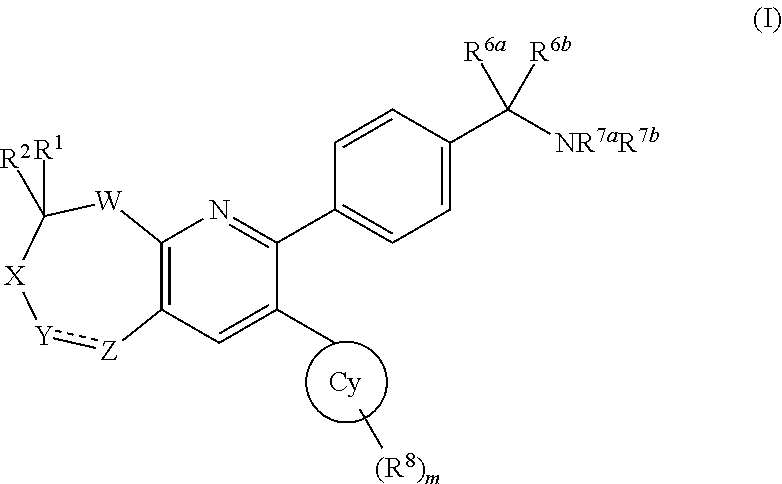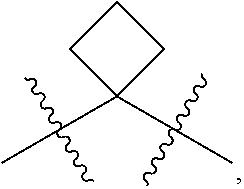Inhibitors of AKT activity
a technology of akt activity and inhibitors, which is applied in the direction of biocide, heterocyclic compound active ingredients, drug compositions, etc., can solve the problems of loss of function, unchecked cell cycle progress and excessive proliferation, increased stage and grade of tumours, etc., and achieves the effect of greater activity
- Summary
- Abstract
- Description
- Claims
- Application Information
AI Technical Summary
Benefits of technology
Problems solved by technology
Method used
Image
Examples
example 1
2-(4-(1-aminocyclobutyl)phenyl)-3-phenyl-7,8-dihydroquinolin-5(6H)-one
[0161]
Step 1: tert-butyl(1-(4-(3-(dimethylamino)-2-phenylacryloyl)phenyl)cyclobutyl)carbamate
[0162]A solution of tert-butyl(1-(4-(2-phenylacetyl)phenyl)cyclobutyl)carbamate (25.0 g, 68 mmol) in N,N-dimethylformamide dimethylacetal (150 mL) was heated to 80° C. under a nitrogen atmosphere for 18 hours. The resulting brown solution was allowed to cool to room temperature and concentrated to dryness under reduced pressure to give the desired product as a yellow / brown solid (30.6 g, quantitative yield). 1H-NMR (500 MHz, CDCl3) δ 7.14-7.48 (10H, m), 5.09 (1H, br s), 2.74 (6H, s), 2.45-2.60 (4H, m), 2.04-2.16 (1H, m), 1.80-1.90 (1H, m), 1.10-1.52 (9H, br m).
Step 2: tert-butyl(1-(4-(5-oxo-3-phenyl-5,6,7,8-tetrahydroquinolin-2-yl)phenyl)cyclobutyl)carbamate
[0163]To acetic acid (120 mL) was added molecular sieves (5 Å, 1.50 g), tert-butyl(1-(4-(3-(dimethylamino)-2-phenylacryloyl)phenyl)cyclobutyl)carbamate (8.00 g, 19.0 mm...
example 2
2-(4-(1-aminocyclobutyl)phenyl)-3-phenyl-7,13-dihydroquinolin-5(6H)-one oxime
[0165]
Step 1: Tert-butyl (1-(4-(5-(hydroxyimino)-3-phenyl-5,6,7,8-tetrahydroquinolin-2-yl)phenyl)cyclobutyl)carbamate
[0166]To a solution of tert-butyl-(1-(4-(1-aminocyclobutyl)phenyl)-3-phenyl-7,8-dihydroquinolin-5(6H)-one (80 mg, 0.17 mmol) in anhydrous ethanol (2.0 mL) was added hydroxylamine hydrochloride (65 mg, 0.9 mmol) and pyridine (75 μL, 0.9 mmol). The resulting yellow solution was heated to 90° C. for 2 hours under a nitrogen atmosphere. The reaction mixture was allowed to cool to room temperature and concentrated to dryness under reduced pressure. The residue was mixed with water (2.0 mL) and extracted into dichloromethane (3×2.0 mL). The combined organic phases were washed with brine (2×4.0 mL), dried over Na2SO4, filtered and concentrated to dryness under reduced pressure to give a yellow oil. The residue was purified by Biotage chromatography (silica, hexane:ethyl acetate, gradient elution fro...
example 3
2-(4-(1-aminocyclobutyl)phenyl)-3-phenyl-7,8-dihydroquinolin-5(6H)-one O-methyl oxime
[0168]
Step 1: tert-butyl(1-(4-(5-(methoxyimino)-3-phenyl-5,6,7,8-tetrahydroquinolin-2-yl)phenyl)cyclobutyl)carbamate
[0169]To a solution of tert-butyl(1-(4-(5-oxo-3-phenyl-5,6,7,8-tetrahydroquinolin-2-yl)phenyl)cyclobutyl)carbamate (90 mg, 0.19 mmol) in anhydrous ethanol (2.0 mL) was added O-methylhydroxylamine hydrochloride (80 mg, 0.96 mmol) and pyridine (80 μL, 0.99 mmol). The resulting yellow solution was heated to 90° C. under a nitrogen atmosphere. The reaction mixture was allowed to cool to room temperature and concentrated to dryness under reduced pressure. The residue was mixed with water (2.0 mL) and extracted into ethyl acetate (3×2.0 mL). The combined organic phases were washed with brine (2×4.0 mL), dried over Na2SO4, filtered and concentrated to dryness under reduced pressure to give a yellow oil. The residue was purified by Biotage chromatography (silica, hexane:ethyl acetate, gradient...
PUM
| Property | Measurement | Unit |
|---|---|---|
| temperature | aaaaa | aaaaa |
| temperature | aaaaa | aaaaa |
| temperature | aaaaa | aaaaa |
Abstract
Description
Claims
Application Information
 Login to View More
Login to View More - R&D
- Intellectual Property
- Life Sciences
- Materials
- Tech Scout
- Unparalleled Data Quality
- Higher Quality Content
- 60% Fewer Hallucinations
Browse by: Latest US Patents, China's latest patents, Technical Efficacy Thesaurus, Application Domain, Technology Topic, Popular Technical Reports.
© 2025 PatSnap. All rights reserved.Legal|Privacy policy|Modern Slavery Act Transparency Statement|Sitemap|About US| Contact US: help@patsnap.com



